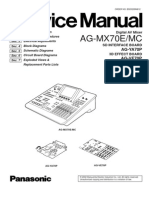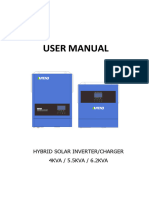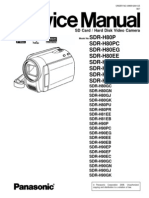Newmar Manual-APS-70 Automatic Power Selector 072514
Newmar Manual-APS-70 Automatic Power Selector 072514
Uploaded by
KulwaCopyright:
Available Formats
Newmar Manual-APS-70 Automatic Power Selector 072514
Newmar Manual-APS-70 Automatic Power Selector 072514
Uploaded by
KulwaCopyright
Available Formats
Share this document
Did you find this document useful?
Is this content inappropriate?
Copyright:
Available Formats
Newmar Manual-APS-70 Automatic Power Selector 072514
Newmar Manual-APS-70 Automatic Power Selector 072514
Uploaded by
KulwaCopyright:
Available Formats
Automatic Power Selector
Model: APS-70
INSTALLATION INSTRUCTIONS
General Description
The APS (Automatic Power Selector) provides a simple, solid-state solution to the need for routing redundant DC power sources for
vital electronic equipment while maintaining isolation of the DC power sources.
Document Note: The APS may be used to facilitate redundant power from any DC power source, such as AC-DC power supplies or
DC-DC converters, as well as batteries. For simplicity of explanation, these instructions refer to batteries as the power source, though
any DC source may be used, as long as both sources are of the same nominal voltage.
Two independent batteries are wired to separate terminals on the APS and internal diodes (also known as “or-ing” diodes) maintain total
isolation between them. A single output is wired to the critical load, which is then powered by the higher voltage source.
Isolation prevents the higher-charged battery from “dumping” into the lower charged or failed battery. Current is drawn automatically
and continuously from the battery with the higher charge, so that there is no interruption of power if one of the batteries fails or becomes
totally discharged.
The APS is rated for loads of up to 70 amps on 12-48 VDC systems. The unit is ruggedly constructed with heavy duty wiring studs and
components in an anodized aluminum case.
Materials Provided
The APS is supplied with a hardware packet containing (4) hex nuts, (4) lock washers, (4) self-tapping mounting screws, (3) terminal
insulation boots (P/N 710-0109-0), and (1) instruction manual. Note: Not all of the hardware will be used in the installation; some spares
are provided.
IMPORTANT: Proper installation requires use of the correct (metric) hardware. If the hardware packet is missing or lost, please contact
NEWMAR for a replacement. If you prefer to acquire hardware locally, request nut size M-6 and compatibly sized washers. For marine
applications use only non-corrosive hardware. Wiring hardware must be situated as shown below.
Wiring Hardware Configuration and Parts Supplied
x 1"
Installation
Refer to the installation diagram on the reverse of this sheet.
1. Shut off all charging sources and disconnect the negative (ground) side of each battery which will be wired to the APS.
2. Mount the APS in a suitable location which will keep wire runs to a minimum length, and is (preferably) ventilated, for cooler
operation. The case of the APS is electrically isolated from the internal diodes, so mounting on either a metal or non-metal surface is
acceptable.
APS-70
072514
P.O. Box 1306 Phone: 714-751-0488
Newport Beach, Fax: 714-957-1621
California 92663 E-Mail: sales@newmarpower.com
www.newmarpower.com
3. Obtain wires (stranded, not solid) of suitable length for the wiring runs, and terminate the ends with 6mm or 1/4" ring lugs (not
supplied). Terminate the other ends as suitable for the load and battery. Refer to the Wire Size Table to determine the correct wire
gauge (based on wire length).
4. Attach the wires to the load and batteries as shown in the installation diagram. Source and Load terminals are identified on a label on
the side of the APS for further clarification. Note: It is always recommended to fuse wiring at the battery.
5. Reconnect the negative battery posts.
IMPORTANT NOTE ABOUT BATTERY SOURCES: Whenever the load is turned on, it can be drawing power from the batteries.
Therefore, if the batteries are not simultaneously being recharged, or if charging will not be available for an extended period, it is
recommended that the load be shut off to prevent complete discharge of batteries.
Wire Size Table
Note: WIRE LENGTH is the combined length of the wire run from the APS to the load and from the APS to the farthest battery.
WIRE LENGTH WIRE SIZE (AWG) WIRE SIZE (MM)
Up to 10' # 6 16
10' - 25' # 4 25
25' - 40' # 2 35
Installation Diagram
Battery 1* Battery 2*
APS
* or other It is recommended that you al-
DC power source ways fuse wiring at the battery
Fuse value determined by load/wire size
(70 amps max. current)
Vital Electronic Load
Specifications
Model: APS-70
Input Voltage Range: 6-50 VDC, negative ground
Maximum Load Current: 70 amps
Operating Temperature: -40° to +80° C; derate linearly from 100% @ 50° C to 70 % @ 80° C
Voltage Drop: Approximately .35 VDC @ 50 % load; .45 VDC @ full load
Dimensions: 3.66 “ x 4.53” x 3.0" (9.3 x 11.5 x 7.6 cm)
P.O. Box 1306 Phone: 714-751-0488
Newport Beach, Fax: 714-957-1621
California 92663 E-Mail: sales@newmarpower.com
www.newmarpower.com
You might also like
- Armour Current - Single Core CablesDocument8 pagesArmour Current - Single Core Cablesmanirup_tceNo ratings yet
- Abc of Capacitors: Basic PrinciplesFrom EverandAbc of Capacitors: Basic PrinciplesWürth ElektronikNo ratings yet
- HRSG StartupDocument19 pagesHRSG Startuptpplant100% (3)
- Dicyanine ADocument5 pagesDicyanine Aregal0746477No ratings yet
- Panasonic - Ag-Mx70 Av MixerDocument172 pagesPanasonic - Ag-Mx70 Av MixerMalay K GhoshNo ratings yet
- Liebert Exs 10kva 60hz 208220v Quick Start GuideDocument21 pagesLiebert Exs 10kva 60hz 208220v Quick Start GuidestuardobsaquicNo ratings yet
- QCK Install ManualDocument4 pagesQCK Install ManuallitoduterNo ratings yet
- MGE Galaxy 7000 3+1 400kVA + SSC 1200kVADocument13 pagesMGE Galaxy 7000 3+1 400kVA + SSC 1200kVAAna RuxandraNo ratings yet
- Manual de Investigação JJJDocument24 pagesManual de Investigação JJJJoão SegundahNo ratings yet
- Anj 4000W 24V WifiDocument32 pagesAnj 4000W 24V Wifigena.kirillovNo ratings yet
- MBC7X 652292Document18 pagesMBC7X 652292Gesiel SoaresNo ratings yet
- Power Failure AlarmDocument17 pagesPower Failure AlarmPurva Patil33% (3)
- RS 485 ConsiderationsDocument5 pagesRS 485 ConsiderationsgeorwashNo ratings yet
- User Manual: Smart-UPS SurtaDocument20 pagesUser Manual: Smart-UPS SurtaLuis Orlando Rios MorenoNo ratings yet
- 4.0 User Manual For TBS Sensors v6Document18 pages4.0 User Manual For TBS Sensors v6Alexandre MandettaNo ratings yet
- User Manual For TBS Bushing SensorsDocument18 pagesUser Manual For TBS Bushing SensorsKusnaediNo ratings yet
- Lecture 11 Electrification of Commercial InstallationDocument7 pagesLecture 11 Electrification of Commercial InstallationBUKENYA BEEE-2026No ratings yet
- Project Repor#2 - CalaguasDocument4 pagesProject Repor#2 - CalaguasfcalaguasNo ratings yet
- Kabelvb TI en 12 VvjyDocument4 pagesKabelvb TI en 12 VvjyVenkataramanan SNo ratings yet
- Subs4 6 8 - IOM - 7 2016FINALDocument12 pagesSubs4 6 8 - IOM - 7 2016FINALFayez Al-ahmadiNo ratings yet
- Analog Electronics Project Report FileDocument17 pagesAnalog Electronics Project Report FileweNo ratings yet
- Abc 11BDocument24 pagesAbc 11BCleto Delacruz LopezNo ratings yet
- Smart Charger Notes & Assembly Instructions: General InformationDocument4 pagesSmart Charger Notes & Assembly Instructions: General Informationanirudh.r.s.No ratings yet
- Pump Plus 1000 PLC: Automatic Single Output Battery ChargerDocument12 pagesPump Plus 1000 PLC: Automatic Single Output Battery ChargerErick Portela cruzNo ratings yet
- Current Transformers Selection Guide PDFDocument20 pagesCurrent Transformers Selection Guide PDFsdvijayNo ratings yet
- Sheet No. Component /detail DescriptionDocument12 pagesSheet No. Component /detail DescriptionhrelectroNo ratings yet
- TransformerLess Low Cost Power SupplyDocument6 pagesTransformerLess Low Cost Power Supplyknk761987No ratings yet
- 10 - Making Voltage and Current MeasurementsDocument10 pages10 - Making Voltage and Current Measurementsk4k4zimNo ratings yet
- Camara Panasonic Sdr-80Document64 pagesCamara Panasonic Sdr-80Francisco Corbalán MolinaNo ratings yet
- Circuit-Test: Operation ManualDocument10 pagesCircuit-Test: Operation ManualLoriene BuenafeNo ratings yet
- AVR Hardware Design ConsiderationsDocument14 pagesAVR Hardware Design ConsiderationsAmarnath M Damodaran100% (1)
- 10 1 1 120 5860 PDFDocument8 pages10 1 1 120 5860 PDFAmit sahaNo ratings yet
- Orion Online rt1 rtx1 1 3kva ManualDocument29 pagesOrion Online rt1 rtx1 1 3kva ManualMANAN BELANINo ratings yet
- ATX Supply DifferentiateDocument5 pagesATX Supply DifferentiatedbmasterNo ratings yet
- SDR H80 PDFDocument64 pagesSDR H80 PDFelita04No ratings yet
- Servicing PLC 120V I/O Modules: 0 CommentsDocument49 pagesServicing PLC 120V I/O Modules: 0 CommentsrajuanthatiNo ratings yet
- GalleonOne 1 3KVA Tower RT ManualDocument34 pagesGalleonOne 1 3KVA Tower RT Manualevanilsonsantana100% (1)
- Dang Nguyen 15 AP2 RC Circuits SDocument9 pagesDang Nguyen 15 AP2 RC Circuits SNguyễn Hoàng ĐăngNo ratings yet
- Smart UPS SURTA3000XLDocument19 pagesSmart UPS SURTA3000XLsaul andinoNo ratings yet
- User Manual: Revo-Ii 3-5kva InverterDocument18 pagesUser Manual: Revo-Ii 3-5kva InverterAymanNo ratings yet
- Basic Electronics LabDocument67 pagesBasic Electronics Labvhince58No ratings yet
- TC-2450 Equipment Case User's Manual ISI-4421-0061 Rev BDocument16 pagesTC-2450 Equipment Case User's Manual ISI-4421-0061 Rev BPeter BoongNo ratings yet
- Manual Ups Plus 2000al 2500alDocument9 pagesManual Ups Plus 2000al 2500albayron_aroldoNo ratings yet
- Electrostatics Voltage Source ManualDocument2 pagesElectrostatics Voltage Source Manualmuzahir.ali.baloch2021No ratings yet
- LG 26LZ5RV-ZC - TCDocument40 pagesLG 26LZ5RV-ZC - TCvideosonNo ratings yet
- Installation of Vibration SensorsDocument8 pagesInstallation of Vibration SensorsnmguravNo ratings yet
- ABYC Advanced PretestDocument36 pagesABYC Advanced PretestdenicotienoNo ratings yet
- TH 32 C 400 DDocument58 pagesTH 32 C 400 DAnonymous nIcSGEwNo ratings yet
- Practical 2P12 Semiconductor Devices: What You Should Learn From This PracticalDocument11 pagesPractical 2P12 Semiconductor Devices: What You Should Learn From This PracticalDevesh GargNo ratings yet
- Proj BatDocument10 pagesProj Bata5436686No ratings yet
- DMC-LS80P Dmc-Ls80Pc Dmc-Ls80Pl DMC-LS80E Dmc-Ls80Eb Dmc-Ls80Ee Dmc-Ls80Ef Dmc-Ls80Eg Dmc-Ls80Gc Dmc-Ls80Gk Dmc-Ls80GnDocument41 pagesDMC-LS80P Dmc-Ls80Pc Dmc-Ls80Pl DMC-LS80E Dmc-Ls80Eb Dmc-Ls80Ee Dmc-Ls80Ef Dmc-Ls80Eg Dmc-Ls80Gc Dmc-Ls80Gk Dmc-Ls80GnRonal Gutierrez100% (1)
- Conductance ManualDocument12 pagesConductance ManualhannibalmrNo ratings yet
- Medi ManualDocument39 pagesMedi ManualBabuPD75% (8)
- Arteche Type CFB Manual 10-0805Document25 pagesArteche Type CFB Manual 10-0805leo232No ratings yet
- Sens Battery ChargerDocument17 pagesSens Battery ChargervjNo ratings yet
- Ebook Emp Herf Shock Pulse Generators Empplans 400j 1.8gw Plan Gun WeaponDocument22 pagesEbook Emp Herf Shock Pulse Generators Empplans 400j 1.8gw Plan Gun Weaponarmandoaltomare100% (2)
- Boat Maintenance Companions: Electrics & Diesel Companions at SeaFrom EverandBoat Maintenance Companions: Electrics & Diesel Companions at SeaNo ratings yet
- Essential Boat Electrics: Carry Out Electrical Jobs On Board Properly & SafelyFrom EverandEssential Boat Electrics: Carry Out Electrical Jobs On Board Properly & SafelyNo ratings yet
- STEM: Science, Technology, Engineering and Maths Principles Teachers Pack V10From EverandSTEM: Science, Technology, Engineering and Maths Principles Teachers Pack V10No ratings yet
- Static-Inverter 1.0: A Complete Design Process to Convert D.C. to A.C. Electricity Using the Astable-MultivibratorFrom EverandStatic-Inverter 1.0: A Complete Design Process to Convert D.C. to A.C. Electricity Using the Astable-MultivibratorNo ratings yet
- Influence of System Parameters Using Fuse Protection of Regenerative DC DrivesFrom EverandInfluence of System Parameters Using Fuse Protection of Regenerative DC DrivesNo ratings yet
- Jicable11 - Armouring Loss in Three-Core Submarine XLPE CablesDocument5 pagesJicable11 - Armouring Loss in Three-Core Submarine XLPE CablesnjmcrawfordNo ratings yet
- Synagas Refiner 23 April 2010Document29 pagesSynagas Refiner 23 April 2010biswacementNo ratings yet
- Service Manual XW180 - Version 01Document76 pagesService Manual XW180 - Version 01Dhinesh ManoharanNo ratings yet
- Indesit W84TX EXDocument38 pagesIndesit W84TX EXAlphaNo ratings yet
- Combustion Gas Analyser: KIGAZ 210Document4 pagesCombustion Gas Analyser: KIGAZ 210Tiberiu MangaNo ratings yet
- Sinterizare Zirconiu Si Carbura 2Document10 pagesSinterizare Zirconiu Si Carbura 2Iulia IuliaaNo ratings yet
- Pollution PPT B.ed Practical (Rashmi) 1Document33 pagesPollution PPT B.ed Practical (Rashmi) 1Ak À ShNo ratings yet
- 2004 Atomic, Molecular and Optical Sciences Research MeetingDocument270 pages2004 Atomic, Molecular and Optical Sciences Research MeetingPocxaNo ratings yet
- Chapter 2 and 3Document40 pagesChapter 2 and 3S S S REDDYNo ratings yet
- PK 18Document1 pagePK 18Oscar A. Pérez MissNo ratings yet
- X Ray EmissionDocument66 pagesX Ray EmissiondanasardyNo ratings yet
- Ip CHE882Document7 pagesIp CHE882Sumit GuptaNo ratings yet
- Mechanical Environmental Studies EST 22447 Unit Test 1Document12 pagesMechanical Environmental Studies EST 22447 Unit Test 1Arvind YadavNo ratings yet
- FMDS0823Document30 pagesFMDS0823thongtn2007No ratings yet
- Nissan D22 ZD30 Turbo SpecsDocument4 pagesNissan D22 ZD30 Turbo SpecsDesron SamuelNo ratings yet
- Drilling Practices - AnnualReportV4 PDFDocument206 pagesDrilling Practices - AnnualReportV4 PDFJorgito AriasNo ratings yet
- Volume Calculations (95% PSV)Document9 pagesVolume Calculations (95% PSV)IGNATIUS MANOSAYNo ratings yet
- Offered Courses in Substation Design CourseDocument4 pagesOffered Courses in Substation Design CoursemidhunrajaasNo ratings yet
- Spec en 4H40Z02304P1-07Document23 pagesSpec en 4H40Z02304P1-07Ageng A. PooNo ratings yet
- Vga 77Document82 pagesVga 77Christian JacintoNo ratings yet
- Ecs 1KD BDocument13 pagesEcs 1KD BMarco Yarasca RomeroNo ratings yet
- 50x70-Poster SafetyChecklist LowresDocument1 page50x70-Poster SafetyChecklist LowresMuhd Khir RazaniNo ratings yet
- Dustfix: Conditioners For Industrial DustsDocument4 pagesDustfix: Conditioners For Industrial DustsvicenteNo ratings yet
- Evergreen Marine Annual Report 2019 PDFDocument462 pagesEvergreen Marine Annual Report 2019 PDFMathew John100% (1)
- Lesson 1.3 The Nuclear Fusion Reactions in StarsDocument14 pagesLesson 1.3 The Nuclear Fusion Reactions in StarsRoscela Mae D. ArizoNo ratings yet
- Carro Lineal MXSDocument38 pagesCarro Lineal MXSmegaNo ratings yet
- Rental Agreement For A Definite Term - Dimitar Borumov - 3P - Schlegelstraat 82Document18 pagesRental Agreement For A Definite Term - Dimitar Borumov - 3P - Schlegelstraat 82kaloyan.ninov01No ratings yet
- Simulation of Cascade H-Bridge Multilevel Inverter With Equal DC Voltage SourceDocument5 pagesSimulation of Cascade H-Bridge Multilevel Inverter With Equal DC Voltage Sourceyr48No ratings yet

























































































